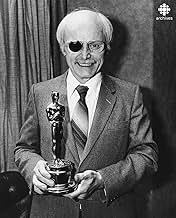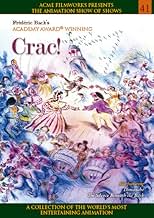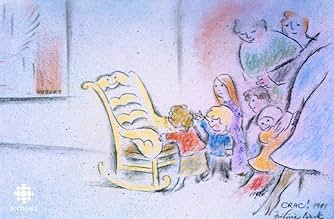Crac
- 1980
- 15 min
AVALIAÇÃO DA IMDb
7,4/10
1,7 mil
SUA AVALIAÇÃO
Adicionar um enredo no seu idiomaThe industrialization of Montreal (Canada), as seen from the point of view of a rocking-chair.The industrialization of Montreal (Canada), as seen from the point of view of a rocking-chair.The industrialization of Montreal (Canada), as seen from the point of view of a rocking-chair.
- Direção
- Roteirista
- Ganhou 1 Oscar
- 3 vitórias no total
Enredo
Você sabia?
- CuriosidadesThe only word in this film that is clearly visible and not distorted is its title, when the tree falls in the beginning.
- ConexõesFeatured in Animated Century (2003)
Avaliação em destaque
Moving images evoke emotions in a manner still frames don't, at least for me. Paintings have always eluded my sense of appreciation because I don't receive signals that would take me into their world. In moving images do I get solace because they visibly attempt at delivering their message. It is the lustrous moving images in Crac that made me cry and fall in love with the beautiful and enchanting world it depicts.
The story is about a craftsman who makes a rocking chair for his love, and after they get married keeps the rocking chair at home while the couple becomes a family with the arrival of children (and plenty of them). The chair is a mute witness to their lives, as it changes from growing green to ripening red and finally fading yellow.
If you look at the Storyline section in IMDb, it says Crac is about the industrialization of Montreal as seen from the view of a rocking chair. This description seems too literal and banal and would discourage youngsters from watching the short. To me, Crac is the celebration of human life in the wonderful, advancing world symbolized in the form of a swaying rocking chair. More than the event, it is the human experience that counts; if we disregard the human aspect that concomitantly progresses in order to adapt to changing circumstances, than we remain narrow-minded. Frederick Back, like the literary stalwart Leo Tolstoy, has enmeshed history and humanity with more poignancy but using hand drawn Impressionistic strokes instead of words, than most modern Pixar films can do with spectacular life-like animation.
Frederic Back's mind works like Walt Disney's as both visualize the world in a profoundly imaginative way. Watch a Walt Disney short and you may find a living train panting and tugging the rail tracks to reach the destination. Similarly, in Crac, the crib inside which a child is play acting turns into the car he imagines. Also, minimalistic paintings come alive and dance surreally in the art gallery. Only a childlike mind could show the images so beautifully without making the action seem corny or saccharine. There are delightful and ingenious moments in Crac, for example, the dance sequence during the marriage where at first, only the craftsman and his wife begin after which a third character magically appears from behind and then the entire space is filled with happy couples. Also wonderful is the dreamy sequence of sheep in the sky when the mother is putting her kids to sleep. And the spectacular moment at the art gallery after the curator leaves. Or even the tiny bit in the beginning where the craftsman proposes to the lady and she blushes, and her upper body looks like a heart. But the most striking part is Back's observation of children. In the art gallery, while the adults in their expensive clothes try to make sense out of abstract works, the children are lured by this simple rocking chair, and a ride on it puts a big smile on their faces. Also commendable is the use of music and sounds, which mainly consist of folk music, the echoing sound of a child's laughter, the switch, the bursting bubble gum etc.
I'm borrowing Robert Christgau's words to describe Crac in a nutshell: 'Frederic Back's Crac evinces a remarkable resemblance to care- that is to care, that is to caring in the best, broadest, most emotional sense.' Tell whoever you know to watch it.
My Rating: 5 out of 5
The story is about a craftsman who makes a rocking chair for his love, and after they get married keeps the rocking chair at home while the couple becomes a family with the arrival of children (and plenty of them). The chair is a mute witness to their lives, as it changes from growing green to ripening red and finally fading yellow.
If you look at the Storyline section in IMDb, it says Crac is about the industrialization of Montreal as seen from the view of a rocking chair. This description seems too literal and banal and would discourage youngsters from watching the short. To me, Crac is the celebration of human life in the wonderful, advancing world symbolized in the form of a swaying rocking chair. More than the event, it is the human experience that counts; if we disregard the human aspect that concomitantly progresses in order to adapt to changing circumstances, than we remain narrow-minded. Frederick Back, like the literary stalwart Leo Tolstoy, has enmeshed history and humanity with more poignancy but using hand drawn Impressionistic strokes instead of words, than most modern Pixar films can do with spectacular life-like animation.
Frederic Back's mind works like Walt Disney's as both visualize the world in a profoundly imaginative way. Watch a Walt Disney short and you may find a living train panting and tugging the rail tracks to reach the destination. Similarly, in Crac, the crib inside which a child is play acting turns into the car he imagines. Also, minimalistic paintings come alive and dance surreally in the art gallery. Only a childlike mind could show the images so beautifully without making the action seem corny or saccharine. There are delightful and ingenious moments in Crac, for example, the dance sequence during the marriage where at first, only the craftsman and his wife begin after which a third character magically appears from behind and then the entire space is filled with happy couples. Also wonderful is the dreamy sequence of sheep in the sky when the mother is putting her kids to sleep. And the spectacular moment at the art gallery after the curator leaves. Or even the tiny bit in the beginning where the craftsman proposes to the lady and she blushes, and her upper body looks like a heart. But the most striking part is Back's observation of children. In the art gallery, while the adults in their expensive clothes try to make sense out of abstract works, the children are lured by this simple rocking chair, and a ride on it puts a big smile on their faces. Also commendable is the use of music and sounds, which mainly consist of folk music, the echoing sound of a child's laughter, the switch, the bursting bubble gum etc.
I'm borrowing Robert Christgau's words to describe Crac in a nutshell: 'Frederic Back's Crac evinces a remarkable resemblance to care- that is to care, that is to caring in the best, broadest, most emotional sense.' Tell whoever you know to watch it.
My Rating: 5 out of 5
- sashank_kini-1
- 26 de jul. de 2012
- Link permanente
Principais escolhas
Faça login para avaliar e ver a lista de recomendações personalizadas
Detalhes
Contribua para esta página
Sugerir uma alteração ou adicionar conteúdo ausente



















